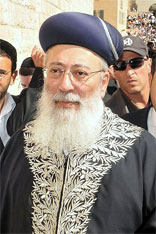Reflections
A Royal Calling: The Rishon L’Tzion
For many years the Sefardic Chief Rabbi of Israel has borne the title ‘Rishon L’Tzion’; this title was first bestowed on the Chief Rabbi of Yerushalayim and over the years it became the standard title for Chief Rabbi of Israel
Whilst at the time of the first Beis Hamikdash the G-d fearing Jews lived united under the leadership of the prophets, as time went by and the nation was plagued with persecution and exile, the community in Yerushalayim was divided into a number of smaller groups. Each community lived independently, establishing its own customs and institutions and choosing its own Rabbanim and leaders.
The Ashkenazic community in Yerushalayim was generally small in number, and for a while Ashkenazim were even prohibited from living in the sacred city because of debts left behind by Rabbi Yehuda haChasid. The Sefardic community in the city was more developed, although it too had known years of difficulty.
The leader of Sefardic Rabbanim in Yerushalayim was traditionally known by the name ‘Rishon L’Tzion’, based on the verse in Sefer Yeshaya: ‘Behold the first of Tzion they are, and to Jerusalem...’ Use of this title began towards the end of the 17th Century, at a time when the Turkish Ottoman Empire ruled the land. The relationship between the Jews and their Turkish overlords was never stable, and the Jewish settlement in Yerushalayim suffered from persecution and heavy taxes. Standing before the Turks on behalf of his suffering brethren was the ‘Rishon L’Tzion’, the Jewish representative whose job it was to enter the chambers of royalty and plead for the plight of his brothers.
 |
| Rabbi Avraham Yitzchak Hakohen Kook,z"l [צלם] |
 |
| Rabbi Yaakov Meir,z"l [צלם] |
The first Rabbi endowed with the title ‘Rishon L’Tzion’ was the great Gaon, Rabbi Moshe Galanti zt’l (the second). Rabbi Moshe was born in Tzfas, and moved to Yerushalayim where he founded a large Yeshiva. Amongst his students was the renowned Rabbi Chizkiyah di Salu – the ‘Pri Chadash’, Rav of Chevron. Rav Moshe was crowned as Chief Rabbi of the Rabbanim in Yerushalayim, and was most beloved by the members of his community. In their profound love and esteem for him, the Sefardic community decided that Rav Moshe would be the only and last Rav to be awarded the title ‘Rav’, and later they began to call him the ‘Rishon L’Tzion’. From then onwards, this title has been bestowed on every Sefardic chief Rabbi in Jerusalem.
 |
| Rabbi Ovadia Yosef, shlit"a [צלם] |
 |
| Rabbi Mordechai Eliyahu, shlit"a[צלם] |
 |
| Rabbi Eliyahu Bakshi Doron[צלם] |
 |
| Rabbi Shlomo Amar[צלם] |
In the year 5602 (1842), the revered Rabbi Chaim Avraham Gegni was appointed Chief Sefardic Rabbi. He was born in Kutcha, Turkey and became the ‘Chacham Bashi’. He was the Chief Rabbi of Turkish Jewry. The Chacham Bashi’s prominent standing was well known amongst the Turkish rulers, and he was crowned in a royal ceremony with an official order that awarded him the title ‘Chacham Bashi’, Rabbi of all Jews of the Ottoman Empire. His task was to act as the Jews’ formal representative before the ruling power.
A number of years after being given the title ‘Chacham Bashi’, Rabbi Chaim Avraham was further bestowed with the title ‘Rishon L’Tzion’. He was the first ever to carry two prestigious titles simultaneously, and after him until the fall of the Ottoman Empire, all Sefardic Chief Rabbis of Yerushalayim bore both the name ‘Chacham Bashi’, and ‘Rishon L’Tzion’.
The Rishon L’Tzion was recognized by the Turks as leader of all Jewry in the holy Land – Ashkenazim and Sefardim alike. This was the case until the years preceding the First World War, at the time when the Rishon L’Tzion Rav Yaakov Shaul Elishur zt’l passed away. Due to various internal problems, after World War I and the occupation of Eretz Yisrael by the British, the official recognition of the position ‘Rishon L’Tzion’ was declared void and for a while the Jews had no official representative acting on their behalf before the British authorities.
When the British Mandate was set up in Eretz Yisrael, its members saw the need to establish a Jewish Rabbinate and thus the committee headed by High Commissioner Herbert Samuels decided to establish the Chief Rabbinate of Israel. At the head of the Rabbinate stood two Chief Rabbis – one from the Ashkenazic community and the other from the Sefardic sect. The two great personalities chosen for these positions were the Gaon Rabbi Avraham Yitzchak haKohen Kook, Chief Rabbi of the Ashkenazi community, and the great Rav Yaakov Meir zt’l, the Sefardic Chief Rabbi. With the establishment of the Rabbinate and the return of the position of ‘Sefardic Chief Rabbi’, the ancient title ‘Rishon L’Tzion’ was once again bestowed as a symbol of prestige and honor.
Until today, any Chief Rabbi appointed on behalf of the Sefardic community is crowned with the title Rishon L’Tzion, and even after they step down from their position the title remains. Examples include the Gaon Rav Ovadia Yosef Shlita, Rav Mordechai Eliyahu, and Rav Eliyahu Bakshi Doron Shlita. Currently serving as Sefardic Chief Rabbi and bearing the title Rishon L’Tzion, is the revered Rabbi Shlomo Amar, Shlita.
According to Sefardic tradition, the Rishon L’Tzion wears a deep blue cloak, embroidered in gold or silver thread with ornamental flowers and leaves. On his head the Rishon L’Tzion wears a distinctive turban. This distinguished garb serves until today as the official attire of a Sefardic Chief Rabbi – a true ‘Rishon L’Tzion’.






